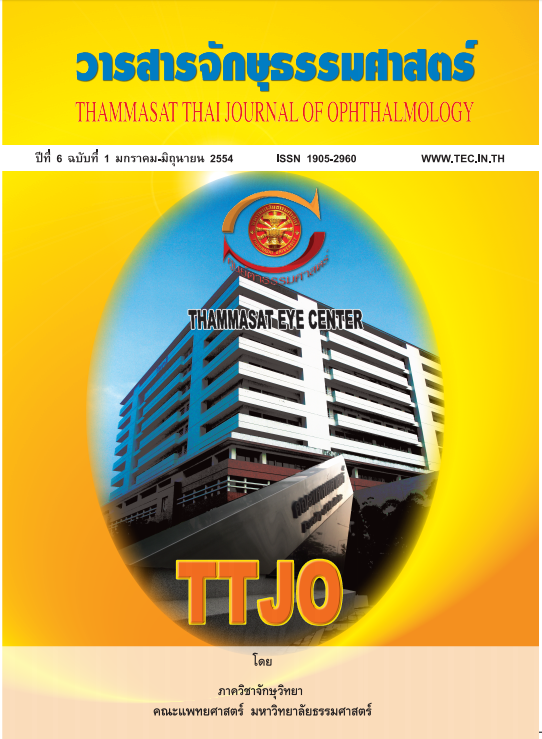เปรียบเทียบผลการขยายรูม่านตาของ 1% Tropicamide Eyedrop ในการขยายรูม่านตาระหว่างบริหารยาแบบหยอดและแบบใส่สำลี สอดใต้เปลือกตาล่างในผู้ป่วยโรคเบาหวาน
Main Article Content
Abstract
บทนำ
การตรวจหาความผิดปกติในลูกตา เช่น จอ ประสาทตา มีความจำเป็นอย่างยิ่งที่จะต้องขยายรูม่านตา โดยทั่วไปจักษุแพทย์นิยมใช้ยาสองชนิดร่วมกัน ได้แก่ ยาที่มีผลกระตุ้นระบบ sympathetic ได้แก่ phenylephrine และยาที่มีผลยับยั้งระบบ parasympathetic (cholinergic) ได้แก่ tropicamide โดยที่แผนกตา ผู้ป่วยนอก โรงพยาบาลธรรมศาสตร์นิยมใช้ 1% tropicamide ร่วมกับ 10% phenylephrine
1% tropicamide เป็นยาที่มีฤทธิ์ทำให้รูม่านตาขยาย (mydriasis) โดยยับยั้งการทำงานของกล้ามเนื้อหดรูม่านตา มีฤทธิ์ระยะสั้น โดยมีฤทธิ์ maximum mydriasis ภายใน 20-40 นาที โดยเฉลี่ยรูม่านตาจะขยายเพิ่มขึ้น 4 มิลลิเมตร โดยประมาณที่ระยะเวลา 30 นาทีหลังจากหยอดยา จากนั้น รูม่านตาจะเริ่มหดเล็กลงกลับเป็นขนาดก่อนหยอดยา ที่ระยะเวลา 6 ชั่วโมง1
เนื่องจากผู้ป่วยเบาหวานมีความจำเป็นจะต้อง หยอดยาขยายรูม่านตาเพื่อตรวจภาวะเบาหวานจอตา แต่ผู้ป่วยกลุ่มนี้มักพบรูม่านตาที่มีขนาดเล็ก ซึ่งมักจะ ไม่ขยายในที่มืด โดยปรากฏการณ์นี้สามารถอธิบาย ได้เนื่องจากผู้ป่วยกลุ่มนี้จะมีภาวะ neuropathy of sympathetic innervation ของกล้ามเนื้อที่ทำหน้าที่ขยาย รูม่านตา2 นอกจากนี้ยังพบว่าการลดลงของ sympathetic activity สัมพันธ์กับอายุ เนื่องจาก degenerative process ซึ่งพบว่าเกิดเร็วมากขึ้นในผู้ป่วยเบาหวานอีกด้วย1,2
Comparitive Study of Mydriatics Effect of 1% Tropicamide Eyedrop between Instillation and Cotton-Applicator Methods in Patients with Diabetes Mellitus
Abstract
Aim: To compare the efficiency of 1% tropicamide eyedrop with different techniques between 5-minute instillation and 10-minute instillation with cotton-tipped applicator methods in diabetic patients.
Method: In a randomized controlled study, one drop of 1% tropicamide was instilled in one eye for every 5 minutes while maintaining a 10-minute instillation with cotton-tipped applicator in another eye. Horizontal pupil diameter was measured before instillation and 10, 20, 30 and 40 minutes after instillation and compared between groups. Duration of diabetes, level of fasting blood sugar and HbA1C were recorded in each group. Anterior chamber depth grading was done to exclude angle closure group. Blood pressure, ocular surface irritation and degree of discomfort were also collected before and after the instillation.
Results: A cohort of 40 patients with 17 male and 23 female had a mean age of 58.48 years old. Mean horizontal pupil diameter after 40 minutes in 5-minute and 10-minute instilled eyes with cotton-tipped applicator were 6.60 mm and 6.63 mm respectively (P = 0.66, Pair-T Test). 17.5 percent of 10-minute instillation with cotton-tipped applicator methods had a mild degrees of discomfort compared to 2.5 percent of 5-minute instillation method.
Conclusions: Both techniques had an equal effect in terms of mydriasis. Pupil size dilation at every interval after instillation in both methods had no significant difference and was sufficient for successful ophthalmoscope.
Article Details
References
Blansett DK. Dilation of the pupil. In:Bartlett JD, Jannus SD, editors.Clinical Ocular Pharmacology. 4th ed. Boston: Butterworth; 2001. pp.125–139.
Smith SA, Smith SE. Evidence for a neuropathic aetiology in the small pupil of diabetes mellitus. Br J Ophthalmol 1983;67:89–93.
Indu Pal Kaur, Meenakshi Kanwar. Review ocular preparations: the formulation approach. Drug Development and Industrial Pharmacy.2002; 473–93.
American Acadamy of Ophalmology.Basic and clinical science course. Section 2;2008-2009; 381-83.
D Pittasch, R Lobmann, H Lehnert, W Behrens-Bauman. Pupillary autonomic denervation and diabetes mellitus. Br J Ophthalmol 2002;86:1319.
Jung BH, Kim SY. Pupillary dilation with mydriatics in diabetic retinopathy. J Korean Ophthalmol Soc 1992;33:495–500. 2004;88:920-24.
Mark Cahill, Peter Eustace, Victor de Jesus. Pupillary autonomic denervation with increasing duration of diabetes mellitus. Br J Ophthalmol 2001;85:1225-30
Van Herick W, Shaffer RN, Schwartz A. Estimation of width of angle of anterior chamber. Incidence and significance of the narrow angle. Am J Ophthalmol 1969; 68:626-29
John V. Forrester. The eye: basic sciences in practice; 265-72.


